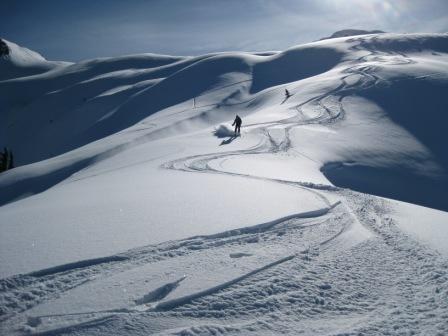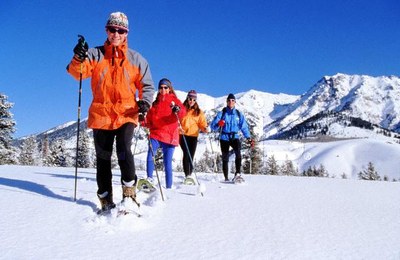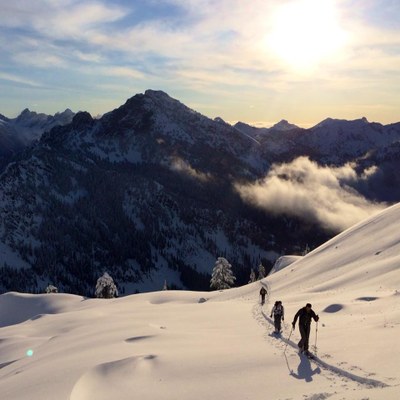
Do you spend time outdoors during the winter? Do you backcountry or cross-country ski, snowboard, snowshoe or enjoy winter mountaineering? If your answer is yes, then you may be impacted by the new rules for Over-Snow Vehicle (OSV) Travel Management.
This new Forest Service rule, currently in draft form, will impact non-motorized winter use in addition to motorized snow vehicles. As winter outdoor recreationists, we often use both types travel to get outside: snow mobiles to get in on closed roads before we transition to skis or snow shoes or attempt a peak. This is an opportunity to voice how you'd like to see balance implemented for all types of Forest recreation, motorized and human-powered alike.
At The Mountaineers, we support both motorized and non-motorized access to Forest Service lands and regulating backcountry use by designating specific trails and areas where OSV use may occur. This draft is a good step forward. To that end, we want to share our concerns and recommendations for the new rule.
Winter travel planning is an opportunity to address and improve user conflict, minimize resource damage on National Forest lands, and bring balance to the backcountry.
Read on to learn more about our concerns and recommendations for the draft rule, what you can do, and where you can learn more on this issue.

Concerns and Recommendations
1. Individual forests or ranger districts can choose to implement an “open unless designated closed” approach (the status quo) or a “closed unless designated open.”
Concern: This would allow ranger districts to take no action – leaving areas open to OSV use as they are currently. A number of areas could experience negative impact to the human-powered experience if OSV is allowed. We would like to see the Forest Service to better manage conflict areas, allowing for both human-powered and motorized areas.
Our recommendation: The Forest Service’s travel management rule for off road vehicles (the non-winter equivalent of OSVs) is the ‘closed unless designated open’ approach. We would like to see this same approach for winter use.
2. The draft appears to grandfather-in a range of past designations for over-snow vehicle use.
Concern: This could allow past administrative decisions that were not comprehensive in scope, analysis, or public involvement to count as travel plans. While some Forests or Ranger Districts might have undertaken plans aimed toward minimizing user conflict and resource damage, and involved the public in a meaningful way, we do not feel this has been the norm in many areas here in Washington State.
Our recommendation: We would like to see a process that identifies aspects of what a comprehensive process looks like and that calls for Forests to undertake a comprehensive planning.
3. Mention of other types of winter travel in the draft
Concern: The draft nowhere mentions other types of winter recreation or travel (i.e., skiing, snow shoeing, etc.). Only OSV use and impact are mentioned. We are concerned this will translate into Forests not having to take conflicts between motorized travel and human-powered travel into account.
Our recommendation: The Forest Service needs to issue a final over-snow vehicle rule consistent with Executive Order 11644. Executive Order 11664 requires the regulation of off-road vehicles – including OSVs – to specific routes and areas, allowing for equitable access for both motorized and non-motorized recreation. By issuing a final over-snow vehicle rule consistent with EO 11644, each ranger district must take into account motorized and human-powered recreation uses, as well as OSV impact on the environment and other forest resources.

What you can do
If any of these issues ring true to your winter experiences on public lands, share your thoughts with the Forest Service. Their comment period is open until August 4, and a comment is the best way to get your voice heard.
Winter Wildlands Alliance (WWA), our partner through the Outdoor Alliance, strongly recommends sharing our personal experiences and concerns from the Pacific Northwest to have a significant impact.
WWA has outlined 5 simple steps for commenting on the draft rule, via the Forest Service's site, and has provided a letter template for you to easily leave a comment.
It's also important to note that the WWA are trying to track the number of comments from human-powered winter recreationists. When you submit your comments on the government website (click the blue ‘comment now’ button), you will receive a comment tracking number. Please send that comment ID# to Winter Wildlands Alliance via the form on their website (scroll down 'comment tracking form'), so they can track how many of us non-motorized folks submit comments. Their goal is to rally at least 1,000 human-powered winter enthusiasts to comment on this draft rule. Let’s make this happen!
More Information
We recommend the following two sources for more information this draft rule:
- The Forest Service
- Winter Wildlands Alliance's resources on the issue.
---------------------------------------------------------------------------
 Katherine Hollis
Katherine Hollis